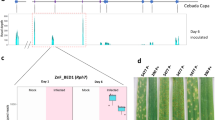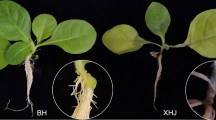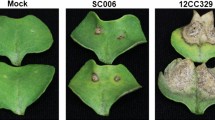Abstract
Infected plants undergo transcriptional reprogramming during initiation of both local defence and systemic acquired resistance (SAR). We monitored gene-expression changes in Arabidopsis thaliana under 14 different SAR-inducing or SAR-repressing conditions using a DNA microarray representing approximately 25–30% of all A. thaliana genes. We derived groups of genes with common regulation patterns, or regulons. The regulon containing PR-1, a reliable marker gene for SAR in A. thaliana, contains known PR genes and novel genes likely to function during SAR and disease resistance. We identified a common promoter element in genes of this regulon that binds members of a plant-specific transcription factor family. Our results extend expression profiling to definition of regulatory networks and gene discovery in plants.
This is a preview of subscription content, access via your institution
Access options
Subscribe to this journal
Receive 12 print issues and online access
$209.00 per year
only $17.42 per issue
Buy this article
- Purchase on Springer Link
- Instant access to full article PDF
Prices may be subject to local taxes which are calculated during checkout





Similar content being viewed by others
References
Somssich, I.E. & Halbrock, K. Pathogen defense in plants–a paradigm of biological complexity. Trends Plant Sci. 3, 86–90 ( 1998).
Ryals, J.L. et al. Systemic acquired resistance. Plant Cell 8, 1809–1819 (1996).
Dong, X. SA, JA, ethylene, and disease resistance in plants. Curr. Opin. Plant Biol. 1, 316–323 ( 1998).
Vernooij, B. et al. Salicylic acid is not the translocated signal responsible for inducing systemic acquired resistance, but is required in signal transduction . Plant Cell 6, 959–965 (1994).
Delaney, T. et al. A central role of salicylic acid in plant disease resistance . Science 266, 1247–1250 (1994).
Lawton, K. et al. Benzothiadiazole induces disease resistance in Arabidopsis by activation of the systemic acquired resistance signal transduction pathway. Plant J. 10, 71– 82 (1996).
Lebel, E. et al. Functional analysis of regulatory sequences controlling PR-1 gene expression in Arabidopsis. Plant J. 16, 223–233 (1998).
Bowling, S.A. et al. A mutation in Arabidopsis that leads to constitutive expression of systemic acquired resistance. Plant Cell 6, 1845–1857 (1994).
Dangl, J.L., Dietrich, R.A. & Richberg, M.H. Death don't have no mercy: cell death programs in plant-microbe interactions. Plant Cell 8, 1793–1807 (1996).
Cao, H., Bowling, S.A., Gordon, S. & Dong, X. Characterization of an Arabidopsis mutant that is non-responsive to inducers of systemic acquired resistance. Plant Cell 6, 1583–1592 (1994).
Delaney, T.P., Friedrich, L. & Ryals, J.A. Arabidopsis signal transduction mutant defective in chemically and biologically induced disease resistance . Proc. Natl Acad. Sci. USA 92, 6602– 6606 (1995).
Depres, D., DeLong, C., Glaze, S., Liu, E. & Fobert, P.R. The Arabidopsis NPR1/NIM1 protein enhances the DNA binding activity of a subgroup of the TGA family of bZIP transcription factors . Plant Cell 12, 279–290 (2000).
Li, X., Zhang, Y., Clarke, J.D., Li, Y. & Dong, X. Identification and cloning of a negative regulator of systemic acquired resistance, SNI1, through a screen for suppressors of npr1-1. Cell 98, 329– 339 (1999).
Zhang, Y., Fan, W., Kinkema, M., Li, X. & Dong, X. Interaction of NPR1 with basic leucine zipper protein transcription factors that bind sequences required for salicylic acid induction of the PR-1 gene. Proc. Natl Acad. Sci. USA 96, 6523–6528 (1999).
Zhou, J.-M. et al. NPR1 differentially interacts with members of the TGA/OBF family of transcription factors that bind an element of the PR-1 gene required for induction by salicylic acid. Mol. Plant Microbe Interact. 13, 191–202 ( 2000).
Maleck, K. & Dietrich, R.A. Defense on multiple fronts: how do plants cope with diverse enemies? Trends Plant Sci. 4, 215–219 ( 1999).
White, K., Rifkin, S., Hurban, P. & Hogness, D. Microarray analysis of Drosophila development during metamorphosis. Science 286, 2179–2184 (1999).
Schena, M., Shalon, D., Davis, R.W. & Brown, P.O. Quantitative monitoring of gene expression patterns with a complementary DNA microarray . Science 270, 467–470 (1995).
Cao, H., Li, X. & Dong, X. Generation of broad spectrum disease resistance by over-expression of an essential regulatory gene in systemic acquired resistance. Proc. Natl Acad. Sci. USA 95, 6531–6536 ( 1998).
Eisen, M.B., Spellman, P.T., Brown, P.O. & Botstein, D. Cluster analysis and display of genome-wide expression patterns. Proc. Natl Acad. Sci. USA 95, 14863– 14868 (1998).
Tamayo, P. et al. Interpreting patterns of gene expression with self-organizing maps: methods and application to hematopoietic differentiation. Proc. Natl Acad. Sci. USA 96, 2907– 2912 (1999).
Uknes, S. et al. Biological induction of systemic acquired resistance in Arabidopsis . Mol. Plant Microbe Interact. 6, 692 –698 (1993).
Oh, S.A., Lee, S.Y., Chung, I.K., Lee, C.H. & Nam, H.G. A senescence-associated gene of Arabidopsis thaliana is distinctively regulated during natural and artificially induced leaf senescence . Plant Mol. Biol. 30, 739– 754 (1996).
Park, J.H., Oh, S.A., Kim, Y.H., Woo, H.R. & Nam, H.G. Differential expression of senescence-associated mRNAs during leaf senescence induced by different senescence-inducing factors in Arabidopsis. Plant Mol. Biol. 37, 445– 454 (1998).
Quirino, B.F., Normanly, J. & Amasino, R.M. Diverse range of gene activity during Arabidopsis thaliana leaf senescence includes pathogen independent induction of defense-related genes. Plant Mol. Biol. 40, 267–278 (1999).
Eulgem, T., Rushton, P.J., Robatzek, S. & Somssich, I.E. The WRKY superfamily of plant transcription factors. Trends Plant Sci. 5, 199–206 ( 2000).
Schindler, U., Beckmann, H. & Cashmore, A.R. TGA1 and G-box binding factors: two distinct classes of Arabidopsis leucine zipper proteins compete for the G-box-like element TGACGTGG. Plant Cell 4, 1309– 1319 (1992).
Eulgem, T., Rushton, P.J., Schmelzer, E., Hahlbrock, K. & Somssich, I.E. Early nuclear events in plant defence signalling: rapid activation by WRKY transcription factors . EMBO J. 18, 4689–4699 (1999).
Fukuda, Y. Interaction of tobacco nuclear proteins with an elicitor responsive element in the promoter of a basic class I chitinase gene. Plant Mol. Biol. 34, 81–87 ( 1997).
Rushton, P.J. et al. Interaction of elicitor-induced DNA-binding proteins with elicitor response elements in the promoters of parsley PR1 genes. EMBO J. 15, 5690–5700 ( 1996).
Durrant, W.E., Rowland, O., Piedras, P., Hammond-Kossak, K.E. & Jones, J.D.G. cDNA-AFLP reveales a striking overlap in the race-specific resistance and wound response expression profiles. Plant Cell 12, 963– 977 (2000).
Neuenschwander, U. et al. Is hydrogen peroxide a second messenger of salicylic acid in systemic acquired resistance? Plant J. 8, 227–234 (1995).
Bi, Y.-M., Kenton, P., Mur, L., Darby, R. & Draper, J. Hydrogen peroxide does not function downstream of salicylic acid in the induction of PR protein expression. Plant J. 8, 235–246 ( 1995).
Lamb, C. & Dixon, R.A. The oxidative burst in plant disease resistance. Annu. Rev. Physiol. Plant Mol. Biol. 48, 251–275 ( 1997).
Jabs, T., Dietrich, R.A. & Dangl, J.L. Initiation of runaway cell death in an Arabidopsis mutant by extracellular superoxide. Science 273, 1853–1856 (1996).
Dietrich, R.A. et al. Arabidopsis mutants simulating disease resistance response . Cell 77, 565–578 (1994).
Batz, O., Logemann, E., Reinold, S. & Hahlbrock, K. Extensive reprogramming of primary and secondary metabolism by fungal elicitor or infection in parsley cells. Biol. Chem. 379, 1127–1135 (1998).
Marcotte, E.M., Pellegrini, M., Thompson, M.J., Yeates, T.O. & Eisenberg, D. A combined algorithm for genome-wide prediction of protein function. Nature 402, 83–86 ( 1999).
Glazebrook, J., Rogers, E.E. & Ausubel, F.M. Use of Arabidopsis for genetic dissection of plant defense responses. Annu. Rev. Genet. 31, 547–569 (1997).
Wolter, M., Hollricher, K., Salamini, F. & Schulze-Lefert, P. The mlo resistance alleles to powdery mildew infection in barley trigger a developmentally controlled defence mimic phenotype. Mol. Gen. Genet. 239, 122–128 ( 1993).
Delseny, M., Cooke, R., Raynal, M. & Grellet, F. The Arabidopsis thaliana cDNA sequencing projects. FEBS Lett. 403, 221–224 (1997).
Ruan, Y., Gilmore, J. & Conner, T. Towards Arabidopsis genome analysis: monitoring exprssion profiles of 1400 genes using cDNA microarrays. Plant J. 15, 821–833 (1997).
Felsenstein, J. PHYLIP, Phylogeny Inference Package (Version 3.2). Cladistics 5, 164–166 (1989).
Menkens, A.E., Schindler, U. & Cashmore, A.R. The G-box: a ubiquitious regulatory DNA element in plants bound by the GBF family of bZIP proteins. Trends Biochem. Sci. 20, 506–510 (1995).
Dröge-Laser, W. et al. Rapid stimulation of a soybean protein serine-threonine kinase which phosphorylates a novel bZIP DNA-binding protein, G/HBF-1, during the induction of early transcription-dependent defenses. EMBO J. 16, 726–738 (1997).
Hao, D., Ohme-Takagi, M. & Sarai, A. Unique mode of GCC box recognition by the DNA-binding domain of ethylene-responsive element-binding factor (ERF domain) in plant . J. Biol. Chem. 273, 26857– 26861 (1998).
Menke, F.L.H., Champion, A., Kijne, J.W. & Memelink, J. A novel jasmonate- and elicitor-responsive element in the periwinkle secondary metabolite biosynthetic gene Str interacts with a jasmonate- and elicitor-inducible AP2-domain transcription factor, ORCA2. EMBO J. 18, 4455–4463 (1999).
Solano, R., Stepanova, A., Chao, Q. & Ecker, J.R. Nuclear events in ethylene signaling: a transcriptional cascade mediated by ETHYLENE-INSENSITIVE3 and ETHYLENE-RESPONSE-FACTOR1. Genes Dev. 12, 3703–3714 (1998).
Yang, Y. & Klessig, D.F. Isolation and characterization of a tobacco mosaic virus-inducible myb oncogene homolog from tobacco . Proc. Natl Acad. Sci. USA 93, 14972– 14977 (1996).
Acknowledgements
We thank P. Rushton and I. Somssich for discussion; L. Friedrich, J. Levin and F. Zheng for RNA samples; A. Wiig for technical assistance; P. Epple for critical reading of the manuscript; the ABRC for EST clones; and S.Y. Rhee for calculation of average 5′ UTR lengths in A. thaliana genes. A.L. was supported by an REU supplement to NSF grant IBN-9724075 to J.L.D., and T.E. is the recipient of a Deutsche Forschungsgemeinschaft Post-doctoral Fellowship.
Author information
Authors and Affiliations
Corresponding author
Supplementary information
Rights and permissions
About this article
Cite this article
Maleck, K., Levine, A., Eulgem, T. et al. The transcriptome of Arabidopsis thaliana during systemic acquired resistance. Nat Genet 26, 403–410 (2000). https://doi.org/10.1038/82521
Received:
Accepted:
Issue Date:
DOI: https://doi.org/10.1038/82521
This article is cited by
-
Promoter profiling of Arabidopsis amino acid transporters: clues for improving crops
Plant Molecular Biology (2021)
-
Computational identification of receptor-like kinases “RLK” and receptor-like proteins “RLP” in legumes
BMC Genomics (2020)
-
The genome sequence of star fruit (Averrhoa carambola)
Horticulture Research (2020)
-
Transcriptional reprogramming of major defense-signaling pathways during defense priming and sugarcane-Colletotrichum falcatum interaction
Molecular Biology Reports (2020)
-
Identification of salt-responsive genes using transcriptome analysis in Dunaliella viridis
Journal of Applied Phycology (2020)



